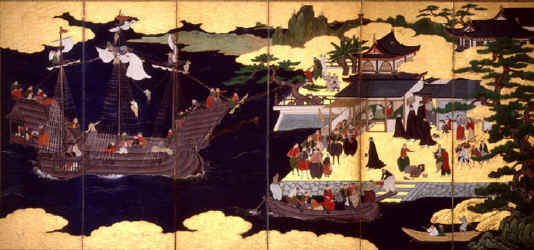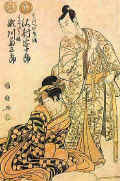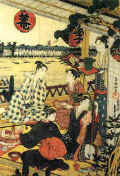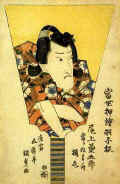|
|
|
|
|
|
|
AsianInfo.org
supports I.C.E.Y. -
H.O.P.E. (non-profit org)
(International
Cooperation of Environmental Youth - Helping Our Polluted
Earth) Any advertisement you view helps save the
environment! Thanks! |
|
|
|
|
|
|

|
|
|
ANCIENT
TIMES
The Jomon
people (10,000 BC - 300 BC),
the first settlers of Japan, made clay figures (dogu)
which mainly represented women. The Yayoi
people (300 BC - 300 AD),
a different immigrant people, made copper weapons,
bronze bells with stick figures drawn on them and
kiln-fired ceramics. Bronze mirrors and clay
sculptures, which were placed outside of tombs,
and murals decorating the inside of the tombs are
contributions from the Kofun period (300 -
710 AD).
The stick
figures on bells and the murals inside tombs are
considered to be the earliest forms of Japanese
painting.
|

THE
INFLUENCE OF BUDDHISM AND CHINA
With the arrival
of Buddhism from Korea and China there was a movement
toward painting, especially with the ruling class taking
such interest in the Buddhist culture and religion.
Painting during the seventh and eight centuries mimicked
styles started in China with illustrations of Buddha's
life and other deities of Buddhism. Painting
became greatly affected by Joko Shinko (Pure Land
Buddhism) after the tenth century.
With the ruling
class' encouragement, construction was started in
different areas for temples and monastic compounds
during the sixth and seventh centuries. Buddhist
art was commissioned for the temples, especially in the
halls and chapels. Some examples are Asukadera,
Shitennoji and Horyuji. Some of the most important
paintings of this period can be found in Horyuji's
Golden Hall which contains murals. In the temples
there are also sculptures that represent the various
Buddhas and other deities.
Back
to Top
Yamato-e started
to replace the Chinese painting style in the middle of
the Heian period. This style can be found on
sliding and folding screen and it shows or depicts the
Kyoto scenery. The album leaf and the illustrated
handscroll (emaki) are two types of painting formats
that came along at the same time. The most
famous emaki painting can be found in the Tales of Genji
(published circa 1130).
With power
changing to the samurai from the nobility, the nobility
managed to keep a vast amount of their wealth and were
patrons of different styles of art. Typical
examples of the nobilities taste in art can be found in
conservatism. This along with realism, the
samurais choice of art, were two major trends found in
the Kamakura period (1185-1333).
The introduction
of architecture and artistic work different from that of
other sects came about with Zen Buddhism in the
thirteenth century. Ink painting became the art
style of choice in the prominent Zen monasteries of
Kamakura and Kyoto, thus taking over scroll painting
styles. Plain and severe monochrome styles were
preferred by Zen painters and their patrons with it's
introduction from Sung (960-1279) and Yuan (1279-1368),
China. Near the end of 1400, these painters
(and patrons) began to prefer monochrome landscape
painting (suibokuga).
Back
to Top
THE
EDO PERIOD (1600-1868)
With the Tokugawa
Shogunate's coming into power in 1600, there was brought
stability, both economically and politically, and peace.
With merchants getting wealthier in Edo (Tokyo) and
Kyoto, they started taking over cultural activities.
Paintings from the
Kan'ei period (1624-1644) depict people from every class
of society crowding the entertainment district beside
Kyoto's Kamogawa river. Similar districts existed
in Osaka and Edo, where the uninhibited lifestyle of the
ukiyo (floating world) transpired. It ultimately
came to be glorified by the art genre know as ukiyo-e.
These ukiyo-e, which often featured brothel districts
and kabuki theater, gained popularity through the
country. First produced in the form of paintings,
by the early eighteenth century, ukiyo-e were most
commonly produced as woodblock prints. Among the
first types of printed ukiyo-e were sensual pictures and
manuals.
By late in the
century, the core activity of ukiyo-e had moved from the
Kyoto-Osaka area to Edo, where portrayals of kabuki
actors became standard subject matter. The public
also showed great fondness for ukiyo-e featuring
beautiful women.
Back
to Top
By the late
eighteenth century, ukiyo-e had entered its golden age.
Feminine beauty and especially the tall, graceful
women who appeared in the work of Torii Kiyonaga was a
dominant theme in the 1780's. After 1790 came a
repid succession of new styles, introduced by artists
who are well known today: Kitagawa Utamaro, Toshusau
Sharaku, Katsushika Hokusai, Ando Hiroshige, and Utagawa
Kuniyoshi, to single out but a few.
For some
Westerners, including the greatest artists in Europe in
the late nineteenth century, ukiyo-e was more than
merely an exotic art form. Artist such as Edgar
Degas and Vincent Van Gogh borrowed its stylistic
composition, perspectives and use of color.
Frequent use of themes from nature, which had been rare
in Western art, wiedened painter' selection of themes.
Emile Galle, a French artist and glass designer, used
Hokusai's sketches of fish in the decoration of his
vases.
With the advent of
the Meiji period (1868-1912) and its policy of
Westernization, ukiyo-e, which had always been closely
linked to the culture from which it drew its themes and
vitality, began to die out quickly.
Meanwhile,
European painting influenced a growing number of
Japanese painters late in the Edo period. Major
artist such as Maruyama Okyo, Matsumura Goshun, and Ito
Jakuchu combined aspects of Japanese, Chinese and
Western styles.
Back
to Top
MODERN
TIMES
Culture in Japan
underwent a rather dramatic transformation during the
Meiji period, when Western technologies and concepts of
government began to be studied and, where appropriate,
adapted for the good of the nation. In the course
of this program of modernization, Western0style painting
received official sanction and the government sent a
number of painters overseas to study.
After some decades
of rivalry between traditional Japanese style and the
new Western-style painting, the Taisho period
(1912-1926) was one in which Western influence on the
arts expanded greatly. Painters such as Umehara
Ryuzaburo and Yasui Sotaro studied and promoted the
styles of Paul Cezanne, Pierre Auguste Renoir and
Camille Pissarro.
Back
to Top
The in pre-World
War II years, however, Yasui and Umehara cast of the
mostly derivative character of Western-style painting in
Japan. Umehara stands out for having brought to
his work elements of Japanese style, an innovation
reversal that encouraged other Western-style painters in
Japan to become more interpretative.
The modernizing of
Japanese painting continued under the guidance of Yasuda
Tukiiko and Kobayashi Kokei. Other painters tried
to spread interest in Japanese-style painting by
adopting popular themes and giving exhibitions more
frequently.
In was early in
the twentieth century that authentic interest in
Western-style sculptures gained momentum, when artists
returned to Japan from study abroad.
Representative of those sculptors was Ogiwara Morie, who
introduced the style of Auguste Rodin and became the
pioneer in the modernization of Japanese sculpture.
Another influential sculptor was Takamura Kotaro who, as
an outstanding poet as well, translated Rodin's views on
art.
Following the
unproductive years of World War II, art in Japan rapidly
regained its originality. Western artistic trends,
after the war, found a quick reception in Japan,
including such developments and pop and op art, primary
structure, minimal art, kinetic art, and assemblage.
Having
traditionally taken their lead from the art of other
cultures, Japanese artists are now finding their own
expression as original creators and contributors to the
world art community.
Back
to Top
Other
Related Sites...
|
|
|
|
|
|









